Quaternary Semiconductor Cd1−xZnxTe1−ySey for High-Resolution, Room-Temperature Gamma-Ray Detection
Abstract
:1. Introduction
2. Challenges of CdZnTe Detectors
3. Role of Se in CdTe and CZT Matrix
4. Growth Techniques of CZTS Single Crystals
5. CZTS Crystal Characterization and Detector Fabrication
5.1. Compositional Characterization
5.2. Crystal Cutting and Detector Fabrication
5.3. Crystal Characterization
6. Charge Transport Properties of CZTS
6.1. The µτ Product Measurement
6.2. Drift Mobility Measurement
7. Radiation Detection with CZTS
8. Study of Intrinsic Defects in CZTS
9. Role of Se Concentration in CZTS
10. Conclusions
Author Contributions
Funding
Institutional Review Board Statement
Informed Consent Statement
Data Availability Statement
Acknowledgments
Conflicts of Interest
References
- Schmidtlein, C.R.; Turner, J.N.; Thompson, M.O.; Mandal, K.C.; Häggström, I.; Zhang, J.; Humm, J.L.; Feiglin, D.H.; Krol, A. Initial performance studies of a wearable brain positron emission tomography camera based on autonomous thin-film digital Geiger avalanche photodiode arrays. J. Med. Imaging 2017, 4, 011003. [Google Scholar] [CrossRef] [PubMed] [Green Version]
- Johns, P.M.; Nino, J.C. Room temperature semiconductor detectors for nuclear security. J. Appl. Phys. 2019, 126, 040902. [Google Scholar] [CrossRef] [Green Version]
- Seco, J.; Clasie, B.; Partridge, M. Review on the characteristics of radiation detectors for dosimetry and imaging. Phys. Med. Biol. 2014, 59, R303–R347. [Google Scholar] [CrossRef] [PubMed] [Green Version]
- Rowland, J.; Kasap, S. Amorphous Semiconductors Usher in Digital X-Ray Imaging. Phys. Today 1997, 50, 24–30. [Google Scholar] [CrossRef]
- Owens, A.; Peacock, A. Compound semiconductor radiation detectors. Nucl. Instrum. Meth. Phys. Res. A 2004, 531, 18–37. [Google Scholar] [CrossRef]
- Schlesinger, T.E.; Toney, J.E.; Yoon, H.; Lee, E.Y.; Brunett, B.A.; Franks, L.; James, R.B. Cadmium zinc telluride and its use as a nuclear radiation detector material. Mater. Sci. Eng. R Rep. 2001, 2001 32, 103–189. [Google Scholar] [CrossRef]
- Szeles, C. CdZnTe and CdTe materials for X-ray and gamma ray radiation detector applications. Phys. Status Soldi B 2004, 241, 783–790. [Google Scholar] [CrossRef]
- Del Sordo, S.; Abbene, L.; Caroli, E.; Mancini, A.M.; Zappettini, A.; Ubertini, P. Progress in the development of CdTe and CdZnTe semiconductor radiation detectors for astrophysical and medical applications. Sensors 2009, 9, 3491–3526. [Google Scholar] [CrossRef] [PubMed]
- Sajjad, M.; Chaudhuri, S.K.; Kleppinger, J.W.; Mandal, K.C. Growth of large-area Cd0.9Zn0.1Te single crystals and fabrication of pixelated guard-ring detector for room-temperature γ-ray detection. IEEE Trans. Nucl. Sci. 2020, 67, 1946–1951. [Google Scholar] [CrossRef]
- Abbene, L.; Principato, F.; Gerardi, G.; Buttacavoli, A.; Cascio, D.; Battelli, M.; Amadè, N.S.; Seller, P.; Veale, M.C.; Fox, O.; et al. Room-temperature X-ray response of cadmium–zinc–telluride pixel detectors grown by the vertical Bridgman technique. J. Synchrotron Radiat. 2020, 27, 319–328. [Google Scholar] [CrossRef] [Green Version]
- Chen, H.; Awadalla, S.A.; Iniewski, K.; Lu, P.H.; Harris, F.; Mackenzie, J.; Hasanen, T.; Chen, W.; Redden, R.; Bindley, G. Characterization of large cadmium zinc telluride crystals grown by traveling heater method. J. Appl. Phys. 2008, 103, 014903. [Google Scholar] [CrossRef] [Green Version]
- Amman, M.; Lee, J.S.; Luke, P.N.; Chen, H.; Awadalla, S.A.; Redden, R.; Bindley, G. Evaluation of THM-grown CdZnTe material for large-volume gamma-ray detector applications. IEEE Trans. Nucl. Sci. 2009, 56, 795–799. [Google Scholar] [CrossRef]
- Roy, U.N.; Burger, A.; James, R.B. Growth of CdZnTe crystals by th travelling heater method. J. Cryst. Growth 2013, 379, 57–62. [Google Scholar] [CrossRef]
- James, R.B.; Schlesinger, T.E.; Lund, J.; Schieber, M. Cd1−xZnxTe spectrometers for gamma and x-ray applications. Semiconduct. Semimet. 1995, 43, 335–381. [Google Scholar] [CrossRef]
- Mandal, K.C.; Kang, S.H.; Choi, M.; Bello, J.; Zheng, L.; Zhang, H.; Groza, M.; Roy, U.N.; Burger, A.; Jellison, G.E.; et al. Simulation, modeling, and crystal growth of Cd0.9Zn0.1Te for nuclear spectrometers. J. Electron. Mater. 2006, 35, 1251–1256. [Google Scholar] [CrossRef]
- Zappettini, A.; Marchini, L.; Zha, M.; Benassi, G.; Zambelli, N.; Calestani, D.; Zanotti, L.; Gombia, E.; Mosca, R.; Zanichelli, M.; et al. Growth and characterization of CZT crystals by the vertical Bridgman method for x-ray detector applications. IEEE Trans. Nucl. Sci. 2011, 58, 2352–2356. [Google Scholar] [CrossRef] [Green Version]
- Roy, U.N.; Camarda, G.S.; Cui, Y.; Gul, R.; Yang, G.; Zazvorka, J.; Dedic, V.; Franc, J.; James, R.B. Evaluation of CdZnTeSe as a high-quality gamma-ray spectroscopic material with better compositional homogeneity and reduced defects. Sci. Rep. 2019, 9, 7303. [Google Scholar] [CrossRef] [PubMed] [Green Version]
- Mandal, K.C.; Kang, S.H.; Choi, M.; Kargar, A.; Harrison, M.J.; McGregor, D.S.; Bolotnikov, A.E.; Carini, G.A.; Camarda, G.S.; James, R.B. Characterization of low-defect Cd0.9Zn0.1Te and CdTe crystals for high-performance Frisch collar detector. IEEE Trans. Nucl. Sci. 2007, 35, 1251–1256. [Google Scholar] [CrossRef]
- Bolotnikov, A.E.; Ackley, K.; Camarda, G.S.; Cui, Y.; Eger, J.F.; De Geronimo, G.; Finfrock, C.; Fried, J.; Hossain, A.; Lee, W.; et al. High-efficiency CdZnTe gamma-ray detectors. IEEE Trans. Nucl. Sci. 2005, 62, 3193–3198. [Google Scholar] [CrossRef]
- Chaudhuri, S.K.; Sajjad, M.; Mandal, K.C. Pulse-shape analysis in Cd0.9Zn0.1Te0.98Se0.02 room-temperature radiation detectors. Appl. Phys. Lett. 2020, 116, 162107. [Google Scholar] [CrossRef] [Green Version]
- Chaudhuri, S.K.; Sajjad, M.; Kleppinger, J.W.; Mandal, K.C. Charge transport properties in CdZnTeSe semiconductor room-temperature γ-ray detectors. J. Appl. Phys. 2020, 127, 245706. [Google Scholar] [CrossRef]
- Hwang, S.; Yu, H.; Bolotnikov, A.E.; James, R.B.; Kim, K. Anomalous Te inclusion size and distribution in CdZnTeSe. IEEE Trans. Nucl. Sci. 2019, 66, 2329–2332. [Google Scholar] [CrossRef]
- Yakimov, A.; Smith, D.; Choi, J.; Araujo, S. Growth and characterization of detector-grade CdZnTeSe by horizontal Bridgman technique. Proc. SPIE 2019, 1114, 111141N. [Google Scholar] [CrossRef]
- Roy, U.N.; Camarda, G.S.; Cui, Y.; James, R.B. Advances in CdZnTeSe for radiation detector applications. Radiation 2021, 1, 123–130. [Google Scholar] [CrossRef]
- Egarievwe, S.U.; Roy, U.N.; Agbalagba, E.O.; Harrison, B.A.; Goree, C.A.; Savage, E.K.; James, R.B. Optimizing CdZnTeSe Frisch-grid nuclear detector for gamma-ray spectroscopy. IEEE Access 2020, 8, 137530–137539. [Google Scholar] [CrossRef]
- Yang, G.; Bolotnikov, A.E.; Fochuk, P.M.; Kopach, O.; Franc, J.; Belas, E.; Kim, K.H.; Camarda, G.S.; Hossain, A.; Cui, Y.; et al. Post-growth thermal annealing study of CdZnTe for developing room-temperature X-ray and gamma-ray detectors. J. Cryst. Growth 2013, 379, 16–20. [Google Scholar] [CrossRef]
- Chen, H.; Awadalla, S.A.; Mackenzie, J.; Redden, R.; Bindley, G.; Bolotnikov, A.E.; Camarda, G.S.; Carini, G.; James, R.B. Characterization of traveling heater method (THM) grown Cd0.9Zn0.1Te crystals. IEEE Trans. Nucl. Sci. 2007, 54, 811–816. [Google Scholar] [CrossRef]
- He, Z. Review of the Shockley–Ramo theorem and its application in semiconductor gamma-ray detectors. Nucl. Instrum. Meth. Phys. Res. A 2001, 463, 250–267. [Google Scholar] [CrossRef]
- Barrett, H.H.; Eskin, J.D.; Barber, H.B. Charge transport in arrays of semiconductor gamma-ray detectors. Phys. Rev. Lett. 1995, 75, 156–159. [Google Scholar] [CrossRef] [Green Version]
- Chaudhuri, S.K.; Krishna, R.M.; Zavalla, K.J.; Matei, L.; Buliga, V.; Groza, M.; Burger, A.; Mandal, K.C. Performance of Cd0.9Zn0.1Te based high-energy gamma detectors in various single polarity sensing device geometries. In Proceedings of the 2012 IEEE Nuclear Science Symposium and Medical Imaging Conference Record (NSS/MIC), Anaheim, CA, USA, 27 October–3 November 2012. [Google Scholar] [CrossRef]
- Krishna, R.M.; Muzykov, P.G.; Mandal, K.C. Electron beam induced current imaging of dislocations in Cd0.9Zn0.1Te crystal. J. Phys. Chem. Solids 2013, 74, 170–173. [Google Scholar] [CrossRef]
- Krishna, R.M.; Hayes, T.C.; Muzykov, P.G.; Mandal, K.C. Low temperature crystal growth and characterization of Cd0.9Zn0.1Te for radiation detection applications. Mater. Res. Soc. Symp. Proc. 2011, 1341, 203. [Google Scholar] [CrossRef]
- McGregor, D.S.; He, Z.; Seifert, H.A.; Wehe, D.K.; Rojeski, R.A. Single charge carrier type sensing with a parallel strip pseudo-Frisch-grid CdZnTe semiconductor radiation detector. J. Appl. Phys. 1998, 72, 792–794. [Google Scholar] [CrossRef] [Green Version]
- Luke, P.N. Single-polarity charge sensing in ionization detectors using coplanar electrodes. Appl. Phys. Lett. 1998, 65, 2884–2886. [Google Scholar] [CrossRef]
- Abbene, L.; Gerardi, G.; Pricipato, F.; Buttacavoli, A.; Altieri, S.; Protti, N.; Tomarchio, E.; Del Sordo, S.; Auricchio, N.; Bettelli, M.; et al. Recent advances in the development of high-resolution 3D cadmium–zinc–telluride drift strip detectors. J. Synchrotron Rad. 2020, 27, 1564–1576. [Google Scholar] [CrossRef] [PubMed]
- Fiederle, M.; Ebling, D.; Eiche, C.; Hofmann, D.M.; Salk, M.; Stadler, W.; Benz, K.W.; Meyer, B.K. Comparison of CdTe, Cd0.9Zn0.1Te and CdTe0.9Se0.1 crystals: Application for γ- and X-ray detectors. J. Cryst. Growth 1994, 138, 529–533. [Google Scholar] [CrossRef]
- Fiducia, T.A.M.; Mendis, B.G.; Li, K.; Grovenor, C.R.M.; Munshi, A.H.; Barth, K.; Sampath, W.S.; Wright, L.D.; Abbas, A.; Bowers, J.W.; et al. Understanding the role of selenium in defect passivation for highly efficient selenium-alloyed cadmium telluride solar cells. Nat. Energy 2019, 4, 504–511. [Google Scholar] [CrossRef] [Green Version]
- Chanda, S.; Ghosh, D.; Debnath, B.; Debbarma, M.; Bhattacharjee, R.; Chattopadhyay, S. Calculations of the structural and optoelectronic properties of cubic CdxZn1−xTe1−ySey semiconductor quaternary alloys using the DFT-based FP-LAPW approach. J. Comput. Electron. 2020, 19, 1–25. [Google Scholar] [CrossRef]
- Kim, K.; Hong, J.; Kim, S. Electrical properties of semi-insulating CdTe0:9Se0:1:Cl crystal and its surface preparation. J. Cryst. Growth 2008, 310, 91–95. [Google Scholar] [CrossRef]
- Roy, U.N.; Bolotnikov, A.E.; Camarda, G.S.; Cui, Y.; Hossain, A.; Lee, K.; Lee, W.; Tappero, R.; Yang, G.; Gul, R.; et al. High compositional homogeneity of CdTexSe1−x crystals grown by the Bridgman method. APL Mater. 2015, 3, 026102. [Google Scholar] [CrossRef]
- Gul, R.; Roy, U.N.; Egarievwe, S.U.; Bolotnikov, A.E.; Camarda, G.S.; Cui, Y.; Hossain, A.; Yang, G.; James, R.B. Point defects: Their influence on electron trapping, resistivity, and electron mobility-lifetime product in CdTexSe1−x detectors. J. Appl. Phys. 2015, 119, 025702. [Google Scholar] [CrossRef]
- Roy, U.N.; Camarda, G.S.; Cui, Y.; Gul, R.; Hossain, A.; Yang, G.; Zazvorka, J.; Dedic, V.; Franc, J.; James, R.B. Role of selenium addition to CdZnTe matrix for room-temperature radiation detector applications. Sci. Rep. 2019, 9, 1620. [Google Scholar] [CrossRef] [PubMed] [Green Version]
- Roy, U.N.; Camarda, G.S.; Cui, Y.; James, R.B. High-resolution virtual Frisch grid gamma ray detectors based on as-grown CdZnTeSe with reduced defects. Appl. Phys. Lett. 2019, 114, 232107. [Google Scholar] [CrossRef]
- Roy, U.N.; Camarda, G.; Cui, Y.; Yang, G.; James, R.B. Impact of selenium addition to the cadmium-zinc-telluride matrix for producing high energy resolution X-and gamma-ray detectors. Sci. Rep. 2021, 11, 10338. [Google Scholar] [CrossRef] [PubMed]
- Hays, E.; Moiseev, A.; Bolotnikov, A.E.; Thompson, D.J.; Kierans, C.A.; Bolotnikov, A.E.; Thompson, D.J.; Kierans, C. A position-sensitive high-resolution CdZnTe calorimeter for AMEGO. In American Astronomical Society Meeting Abstracts; American Astronomical Society: Washington, DC, USA, 2019; Volume 233, Available online: https://ui.adsabs.harvard.edu/#abs/2019AAS...23315826H/abstract (accessed on 15 July 2021).
- Chu, M.; Terterian, S.; Ting, S.; Wang, C.C.; Benson, J.D.; Dinan, J.H.; James, R.B.; Burger, A. Effects of excess tellurium on the properties of CdZnTe radiation detectors. J. Electron. Mater. 2003, 32, 778–782. [Google Scholar] [CrossRef]
- Yang, F.; Jie, W.; Zha, G.; Xi, S.; Wang, M.; Wang, T. The effect of indium doping on deep level defects and electrical properties of CdZnTe. J. Electron. Mater. 2020, 49, 1243–1248. [Google Scholar] [CrossRef]
- Soundararajan, R.; Lynn, K.G. Effects of excess tellurium and growth parameters on the band gap defect levels in CdxZn1−xTe. J. Appl. Phys. 2012, 112, 073111. [Google Scholar] [CrossRef]
- Kleppinger, J.W.; Chaudhuri, S.K.; Roy, U.N.; James, R.B.; Mandal, K.C. Growth of Cd0.9Zn0.1Te1−ySey single crystals for room temperature gamma-ray detection. IEEE Trans. Nucl. Sci. Early Access 2021. [Google Scholar] [CrossRef]
- Egarievwe, S.U.; Hossain, A.; Okwechime, I.O.; Gul, R.; James, R.B. Effects of chemomechanical polishing on CdZnTe x-ray and gamma-ray detectors. J. Electron. Mater. 2015, 44, 3194–3201. [Google Scholar] [CrossRef]
- Bolotnikov, A.E.; Abdul-Jaber, N.M.; Babalola, O.S.; Camarda, G.S.; Cui, Y.; Hossain, A.; Jackson, E.; Jackson, H.C.; James, J.A.; Kohman, K.T.; et al. Effects of Te inclusions on the performance of CdZnTe radiation detectors. IEEE Trans. Nucl. Sci. 2008, 55, 2757–2764. [Google Scholar] [CrossRef] [Green Version]
- Carini, G.A.; Bolotnikov, A.E.; Camarda, G.S.; Wright, W.G.; James, R.B.; Li, L. Effect of Te precipitates on the performance of CdZnTe detectors. Appl. Phys. Lett. 2006, 88, 143515–143517. [Google Scholar] [CrossRef] [Green Version]
- Sellin, P.J.; Davies, A.W.; Gkoumas, S.; Lohstroh, A.; Özsan, M.E.; Parkin, J.; Perumal, V.; Prekas, G.; Veale, M. Ion beam induced charge imaging of charge transport in CdTe and CdZnTe. Nucl. Instrum. Meth. Phys. Res. B 2008, 266, 1300–1306. [Google Scholar] [CrossRef]
- Crocco, J.; Bensalah, H.; Zheng, Q.; Corregidor, V.; Avles, E.; Castalsini, A.; Fraboni, B.; Cavalcoli, D.; Cavallini, A.; Vela, O.; et al. Study of asymmetries of Cd(Zn)Te devices investigated using photo-induced current transient spectroscopy, Rutherford backscattering, surface photo-voltage spectroscopy, and gamma ray spectroscopies. J. Appl. Phys. 2012, 112, 074503. [Google Scholar] [CrossRef]
- Brovko, A.; Amzallag, O.; Adelberg, A.; Chernyak, L.; Raja, P.V.; Ruzin, A. Effects of oxygen plasma treatment on Cd1−xZnxTe material and devices. Nucl. Instrum. Meth. Phys. Res. B 2021, 1004, 165343. [Google Scholar] [CrossRef]
- Zumbiehl, A.; Hage-Ali, M.; Fougeres, P.; Koebel, J.M.; Regal, R.; Siffert, P. Electric field distribution in CdTe and Cd1−xZnxTe nuclear detectors. J. Cryst. Growth 1999, 197, 650–654. [Google Scholar] [CrossRef]
- Yang, G.; Bolotnikov, A.E.; Camarda, G.S.; Cui, Y.; Hossain, A.; Yao, H.W.; James, R.B. Internal electric field investigations of a cadmium zinc telluride detector using synchrotron X-ray mapping and Pockels effect measurements. J. Electron. Mater. 2009, 38, 1563–1567. [Google Scholar] [CrossRef]
- Dědič, V.; Fridrišek, T.; Franc, J.; Kunc, J.; Rejhon, M.; Roy, U.N.; James, R.B. Mapping of inhomogeneous quasi-3D electrostatic field in electro-optic materials. Sci. Rep. 2021, 11, 2154–3010. [Google Scholar] [CrossRef]
- Hecht, K. Zum mechanismus des lichtelektrischen primärstromes in isolierenden kristallen. Z. Phys. 1932, 77, 235–245. [Google Scholar] [CrossRef]
- Pipek, J.; Betušiak, M.; Belas, E.; Grill, R.; Praus, P.; Musiienko, A.; Pekarek, J.; Roy, U.N.; James, R.B. Charge transport and space-charge formation in Cd1−xZnxTe1−ySey radiation detectors. Phys. Rev. Appl. 2021, 15, 054058. [Google Scholar] [CrossRef]
- Chaudhuri, S.K.; Lohstroh, A.; Nakhostin, M.; Sellin, P.J. Digital pulse height correction in HgI2 γ-ray detectors. J. Instrum. 2012, 7, T04002. [Google Scholar] [CrossRef]
- Verger, L.; Boitel, M.; Gentet, M.C.; Hamelin, R.; Mestais, C.; Mongellaz, F.; Rustique, J.; Sanchez, G. Characterization of CdTe and CdZnTe detectors for gamma-ray imaging applications. Nucl. Instrum. Methods Phys. Res. A 2001, 458, 297–309. [Google Scholar] [CrossRef]
- Chaudhuri, S.K.; Zavalla, K.J.; Krishna, R.M.; Mandal, K.C. Biparametric analyses of charge trapping in Cd0.9Zn1.0Te based virtual Frisch grid detectors. J. Appl. Phys. 2013, 113, 074504. [Google Scholar] [CrossRef] [Green Version]
- Bolotnikov, A.E.; Butcher, J.; Camarda, G.S.; Cui, Y.; De Geronimo, G.; Fried, J.; Gul, R.; Fochuk, P.M.; Hamade, M.; Hossain, A.; et al. Array of virtual Frisch-grid CZT detectors with common cathode readout for correcting charge signals and rejection of incomplete charge-collection events. IEEE Trans. Nucl. Sci. 2012, 59, 1544–1551. [Google Scholar] [CrossRef]
- Gul, R.; Roy, U.N.; Camarda, G.S.; Hossain, A.; Yang, G.; Vanier, P.; Lordi, V.; James, R.B. A comparison of point defects in Cd1−xZnxTe1−ySey crystals grown by Bridgman and traveling heater methods. J. Appl. Phys. 2017, 121, 125705. [Google Scholar] [CrossRef]
- Rejhon, M.; Dědič, V.; Beran, L.; Roy, U.N.; Franc, J.; James, R.B. Investigation of deep levels in CdZnTeSe crystal and their effect on the internal electric field of CdZnTeSe gamma-ray detector. IEEE Trans. Nucl. Sci. 2019, 66, 1952–1958. [Google Scholar] [CrossRef]
- Rejhon, M.; Franc, J.; Dedic, V.; Pekárek, J.; Roy, U.N.; Grill, R.; James, R.B. Influence of deep levels on the electrical transport properties of CdZnTeSe detectors. J. Appl. Phys. 2018, 124, 235702. [Google Scholar] [CrossRef] [Green Version]
- Carvalho, A.; Tagantsev, A.; Öberg, S.; Briddon, P.R.; Setter, N. Intrinsic defects in CdTe and CdZnTe alloys. Phys. B. 2009, 404, 5019–5021. [Google Scholar] [CrossRef]
- Roy, U.N.; Camarda, G.S.; Cui, Y.; James, R.B. Optimization of selenium in CdZnTeSe quaternary compound for radiation detector applications. Appl. Phys. Lett. 2021, 118, 152101. [Google Scholar] [CrossRef]
- Chaudhuri, S.K.; Sajjad, M.; Kleppinger, J.W.; Mandal, K.C. Correlation of space charge limited current and γ-ray response of CdxZn1−xTe1−ySey room-temperature radiation detectors. IEEE Electron Device Lett. 2020, 41, 1336–1339. [Google Scholar] [CrossRef]
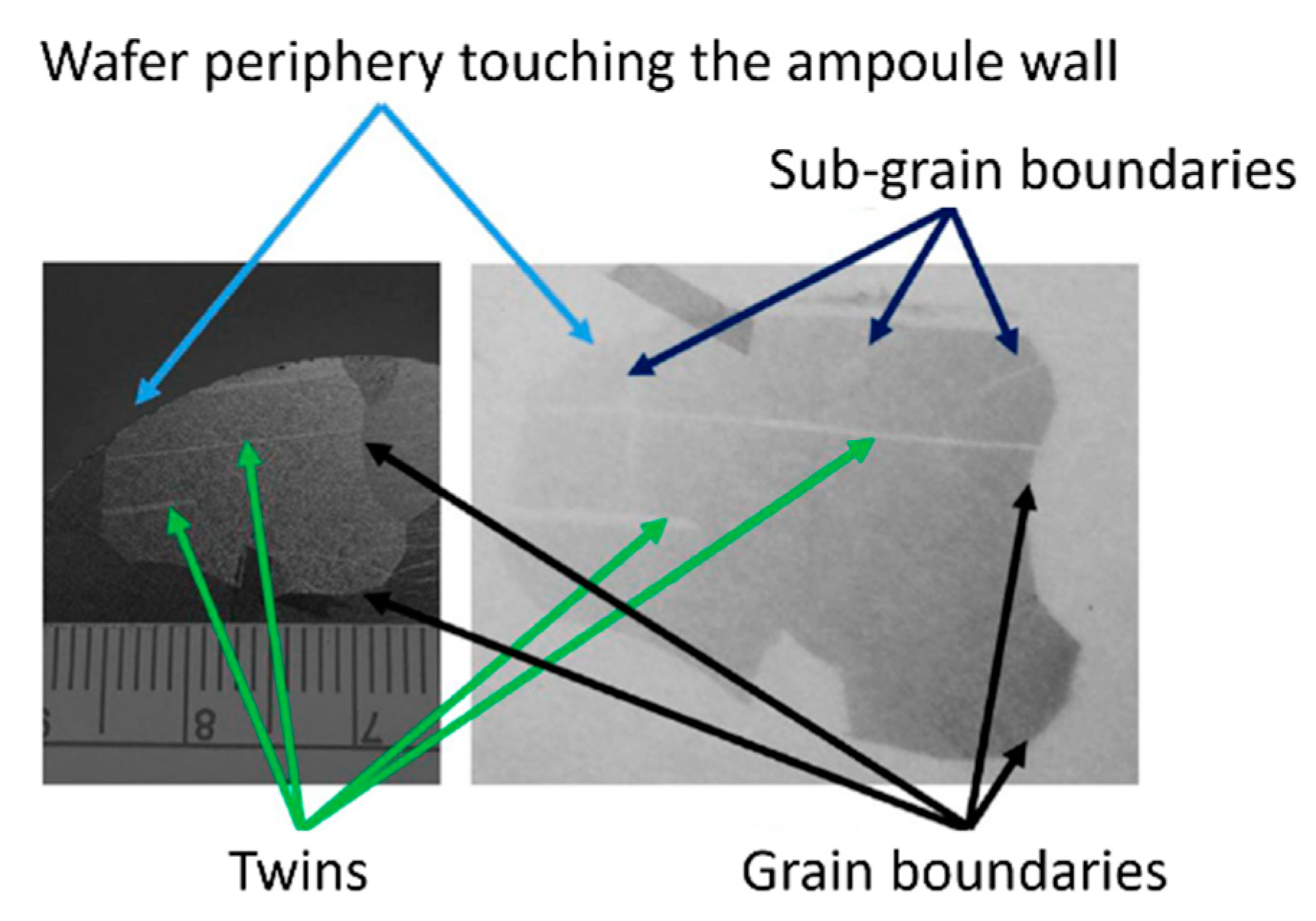
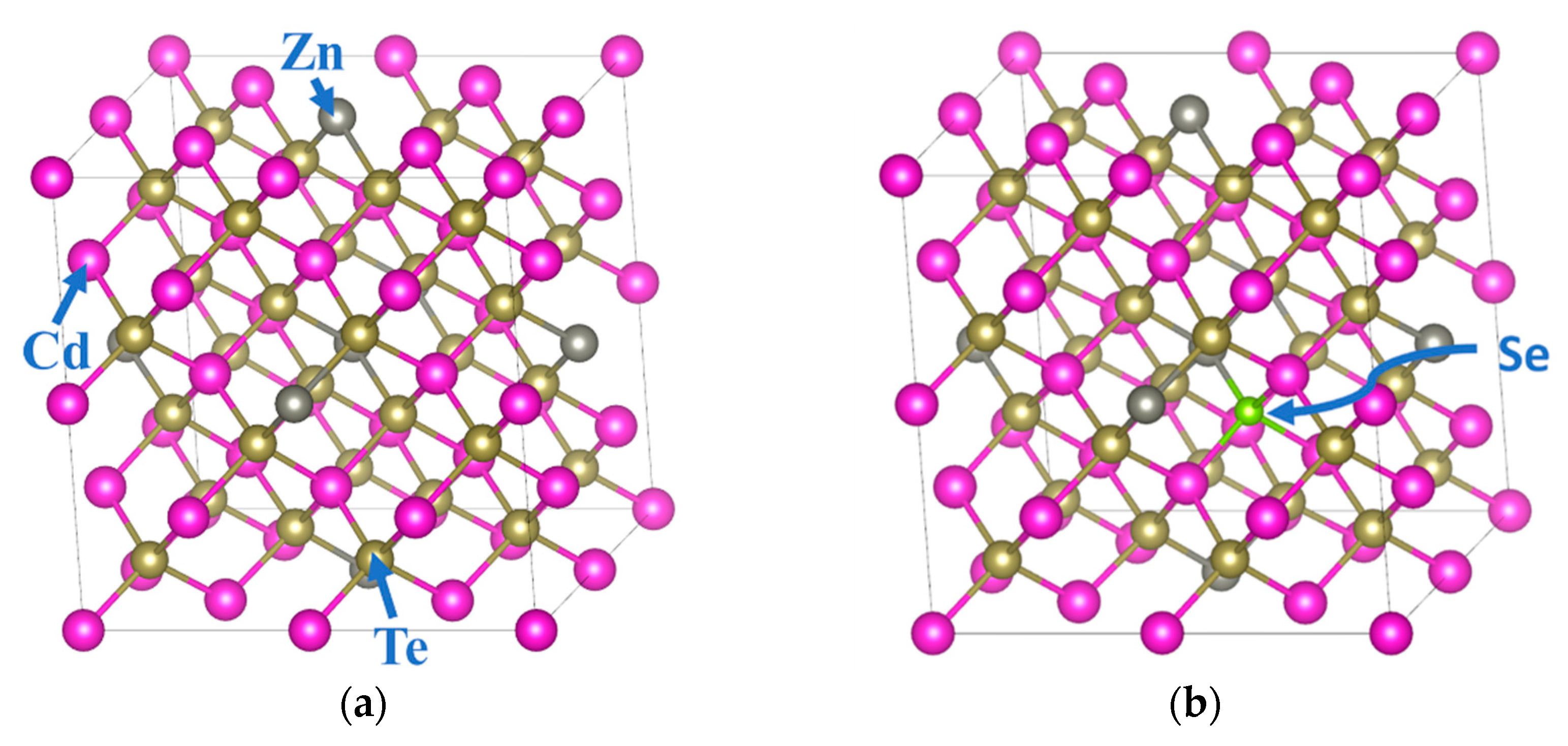



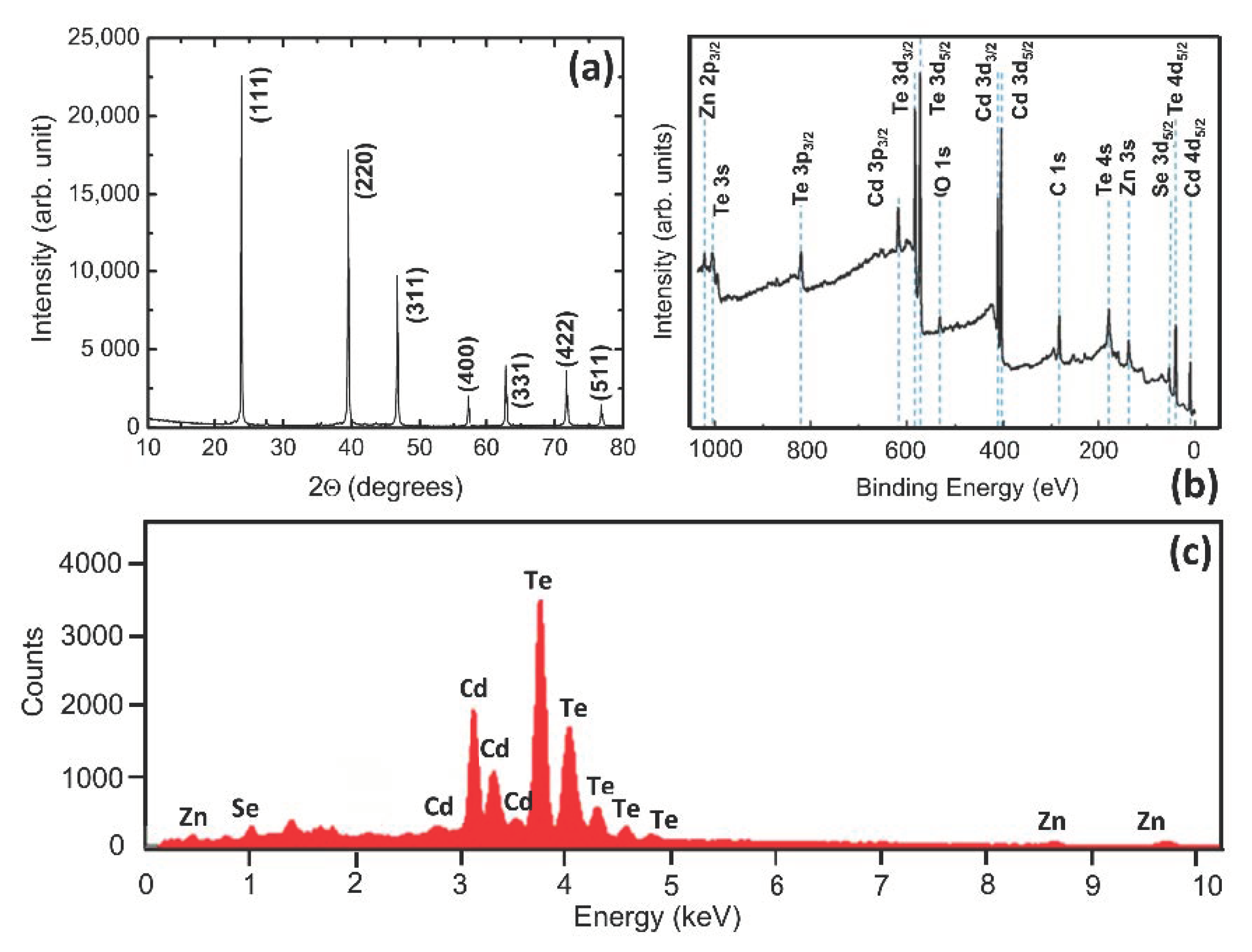

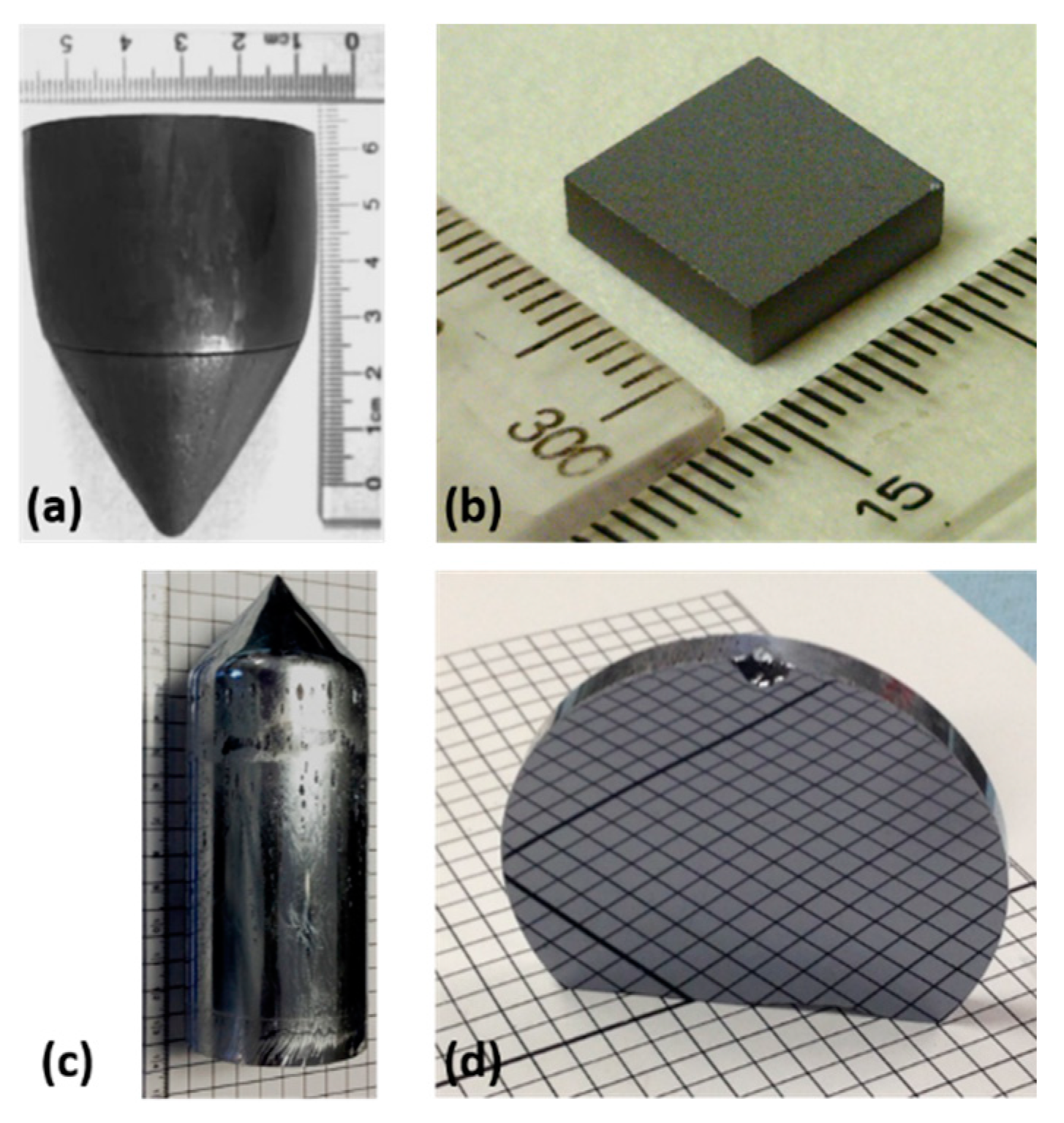
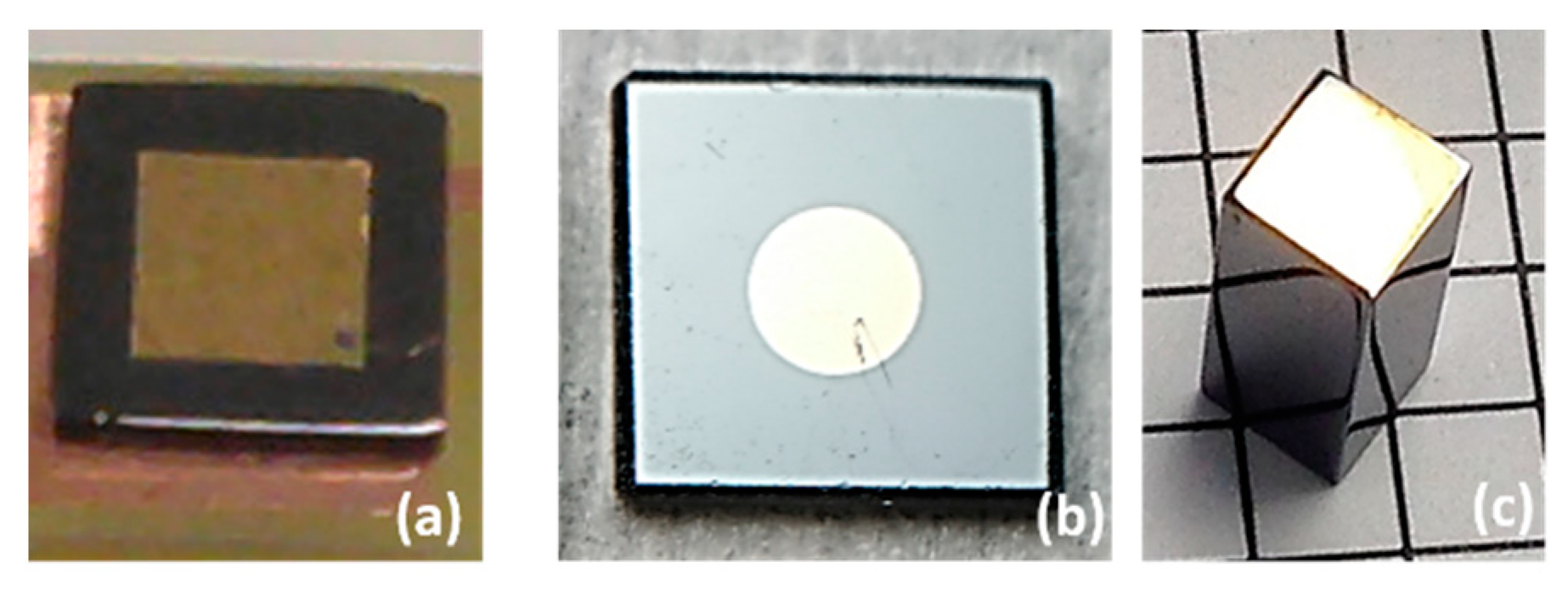


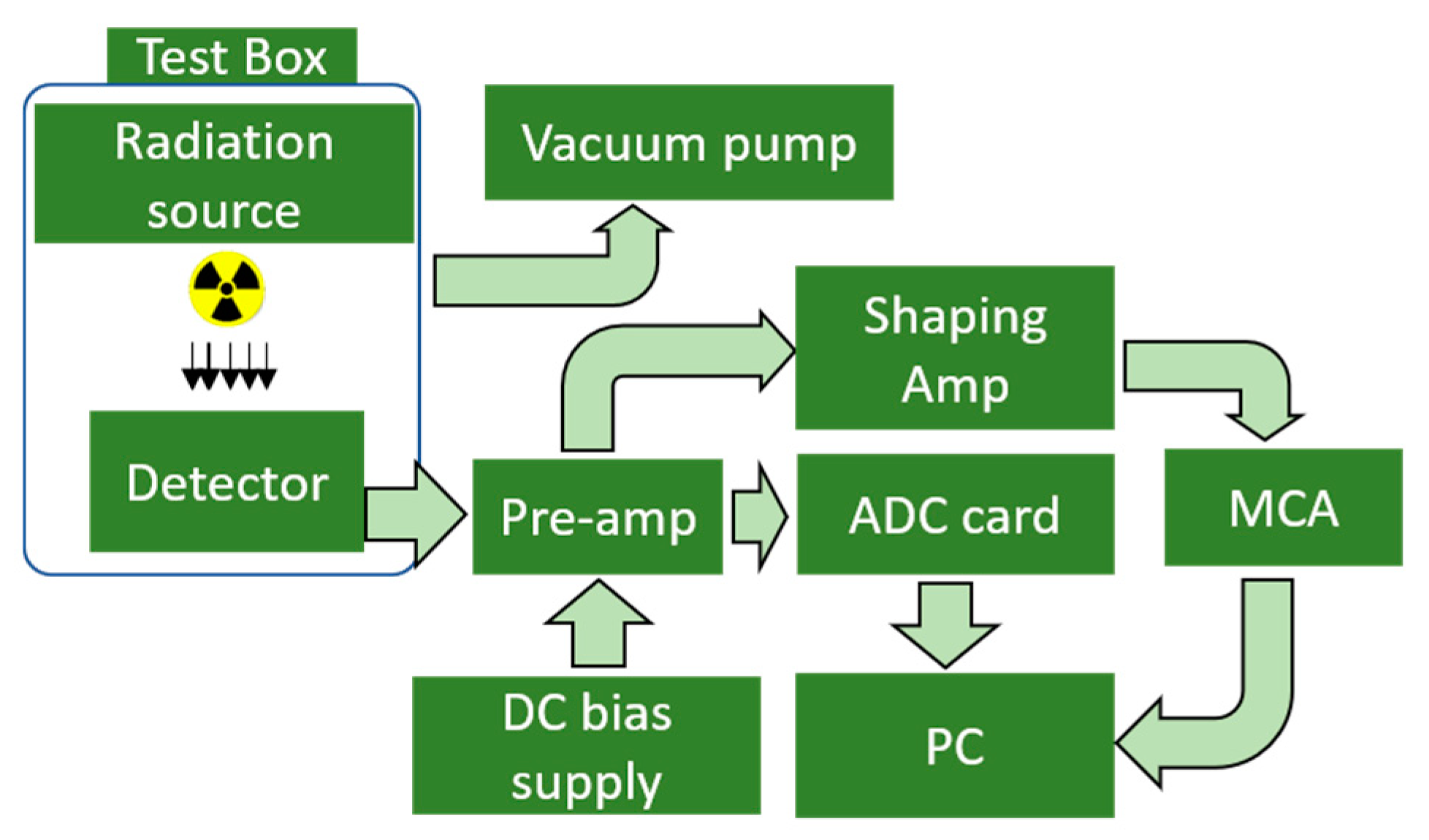
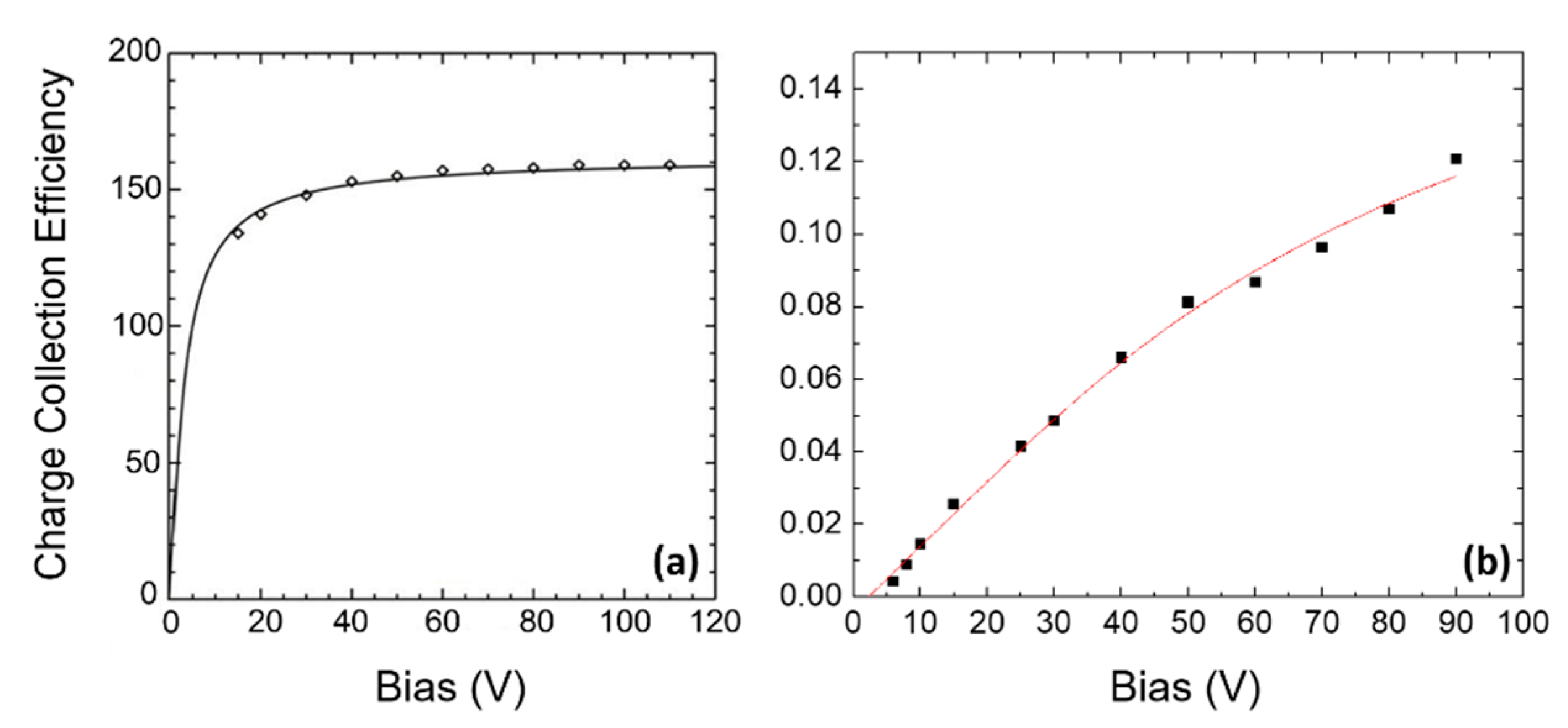
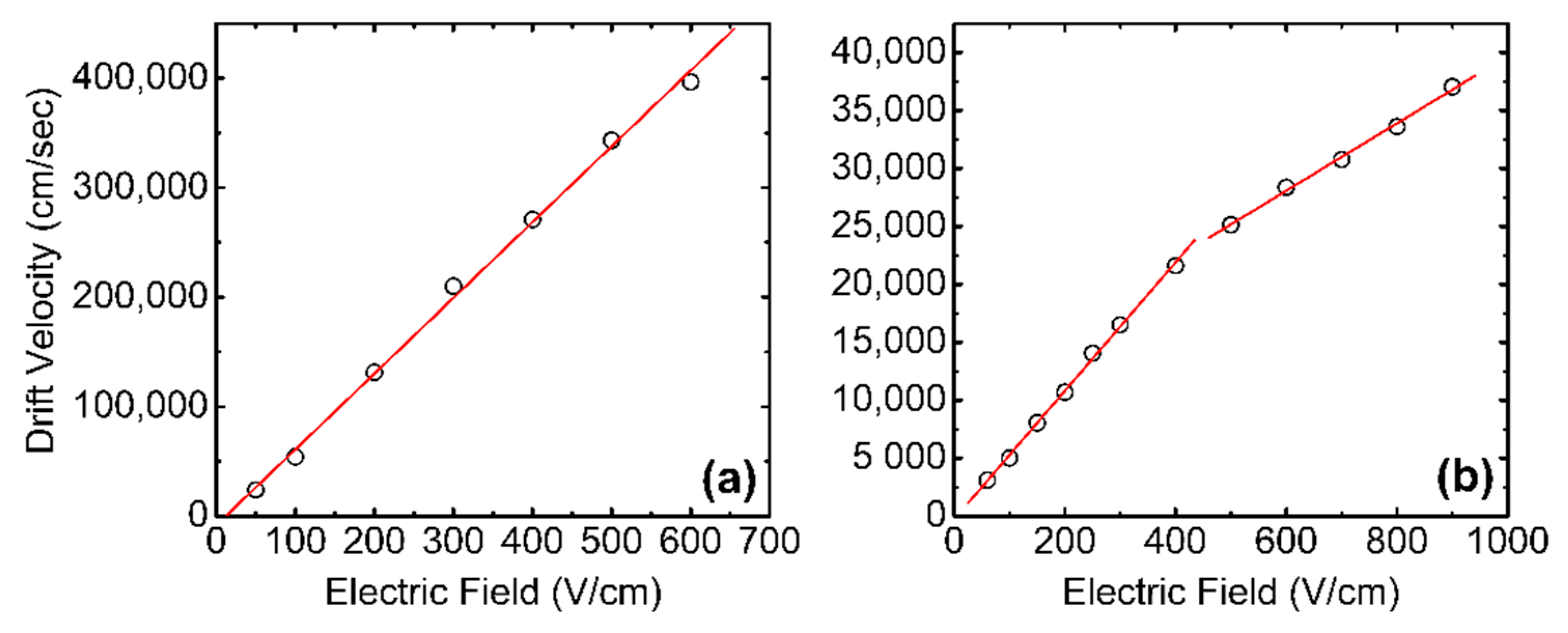
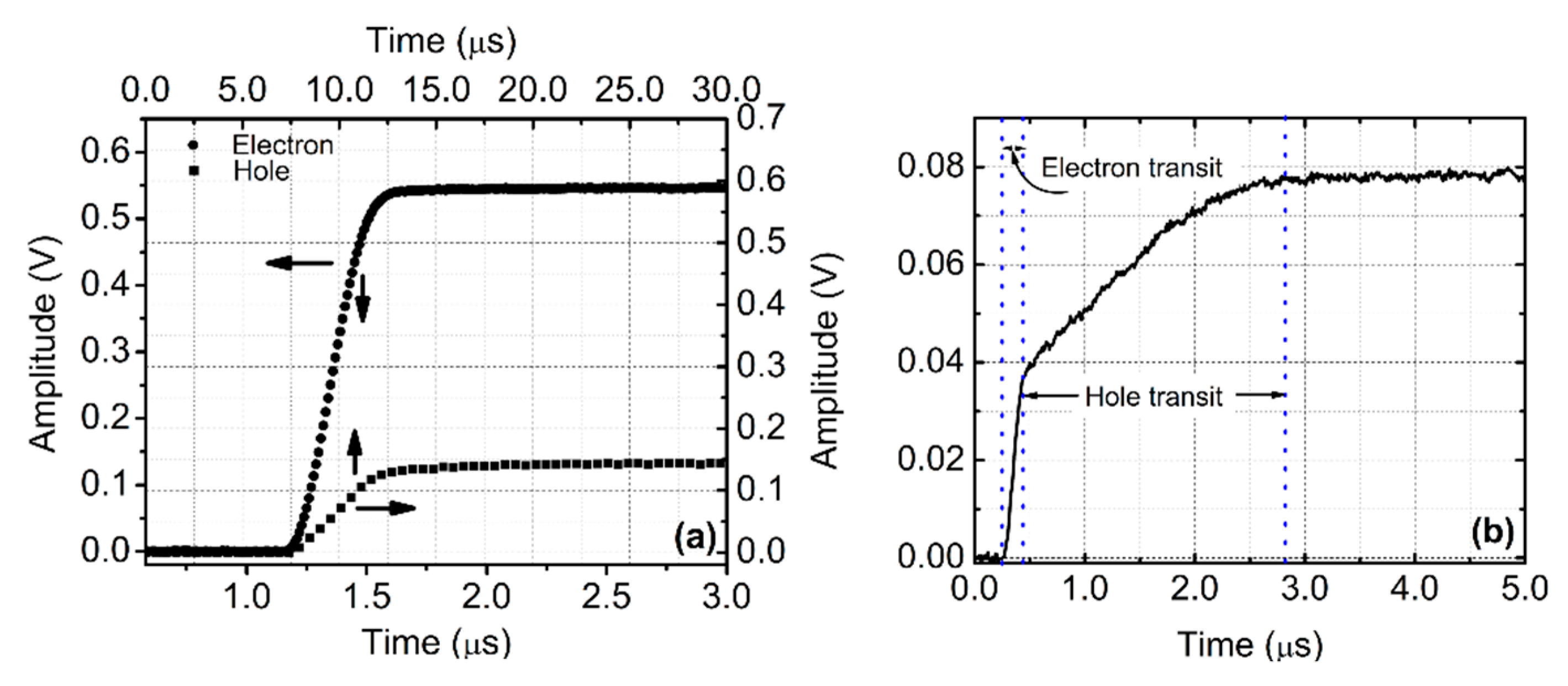
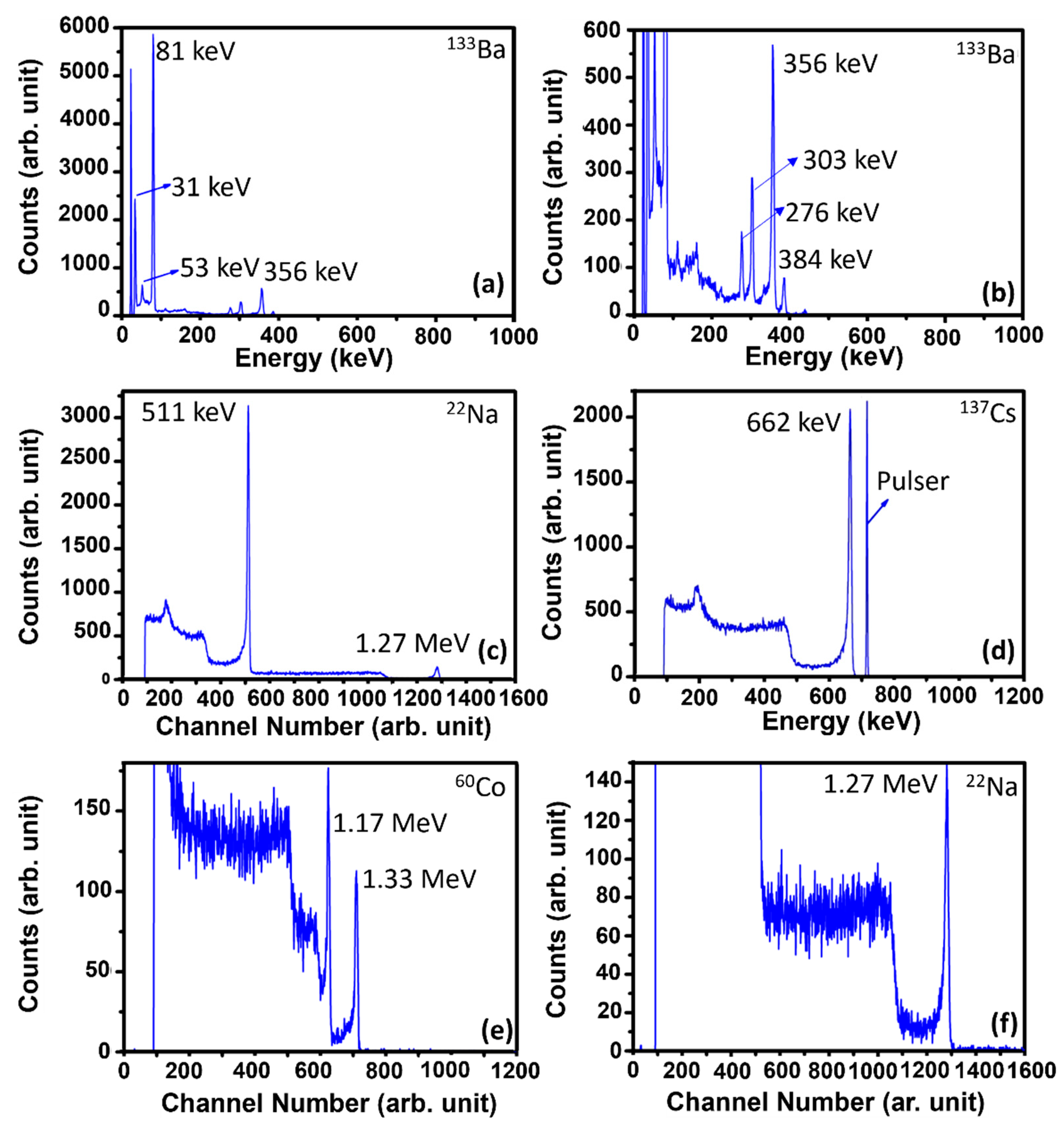

| Radioisotope | Crystal/Detector Type | Gamma-Ray Energy (keV) | Energy Resolution (%) |
|---|---|---|---|
| 133Ba | THM/Frisch collar | 31 | 6.4 a, 9.0 b, 15.0 c |
| “ | “ | 81 | 4.8 a, 4.6 b |
| “ | “ | 276 | 1.77 a, 2.0 b, 1.43 c |
| “ | “ | 303 | 1.7 a, 1.7 b, 1.36 c |
| “ | “ | 356 | 1.7 a, 1.6 b, 1.28 c |
| “ | “ | 384 | 1.2 a, 1.49 c |
| 22Na | THM/Frisch collar | 511 | 1.34 a, 1.26 c |
| 137Cs | “ | 662 | 0.9 a, 1.07 b, 0.77 c |
| 137Cs | VBM/Planar | “ | 2.0 d,* |
| 22Na | THM/Frisch collar | 1275 | 1.0 b, 0.56 c |
| Defect Energy Level (eV) | Possible Defect Identity | Capture Cross Section (cm2) | Crystal Type |
|---|---|---|---|
| 0.19 | - | 1 × 10−19 | Horizontal Bridgman a |
| 0.73 | - | 1 × 10−12 | “ |
| 0.82 | - | 5 × 10−11 | “ |
| 1.02 | - | 7 × 10−11 | “ |
| Donor impurity | 9 × 10−21 | Bridgman ([Se] = 2%); THM ([Se] = 7%) b | |
| Se related donor | 5 × 10−17 | “ | |
| A-center | 1 × 10−16 | “ | |
| 1 × 10−14 | “ | ||
| 1 × 10−15 | Bridgman ([Se] = 2%) b | ||
| 5 × 10−11 | THM ([Se] = 7%) b | ||
| 1 × 10−10 | Bridgman ([Se] = 2%) b | ||
| - | - | [Se] = 4% c | |
| - | 1 × 10−13 | “ | |
| - | - | “ | |
| / | - | 1 × 10−11/1 × 10−15 | “ |
| / | Recombination center | 3.5 × 10−14/6.5 × 10−14 | THM ([Se] = 4%) d |
Publisher’s Note: MDPI stays neutral with regard to jurisdictional claims in published maps and institutional affiliations. |
© 2021 by the authors. Licensee MDPI, Basel, Switzerland. This article is an open access article distributed under the terms and conditions of the Creative Commons Attribution (CC BY) license (https://creativecommons.org/licenses/by/4.0/).
Share and Cite
Chaudhuri, S.K.; Kleppinger, J.W.; Karadavut, O.; Nag, R.; Mandal, K.C. Quaternary Semiconductor Cd1−xZnxTe1−ySey for High-Resolution, Room-Temperature Gamma-Ray Detection. Crystals 2021, 11, 827. https://doi.org/10.3390/cryst11070827
Chaudhuri SK, Kleppinger JW, Karadavut O, Nag R, Mandal KC. Quaternary Semiconductor Cd1−xZnxTe1−ySey for High-Resolution, Room-Temperature Gamma-Ray Detection. Crystals. 2021; 11(7):827. https://doi.org/10.3390/cryst11070827
Chicago/Turabian StyleChaudhuri, Sandeep K., Joshua W. Kleppinger, OmerFaruk Karadavut, Ritwik Nag, and Krishna C. Mandal. 2021. "Quaternary Semiconductor Cd1−xZnxTe1−ySey for High-Resolution, Room-Temperature Gamma-Ray Detection" Crystals 11, no. 7: 827. https://doi.org/10.3390/cryst11070827
APA StyleChaudhuri, S. K., Kleppinger, J. W., Karadavut, O., Nag, R., & Mandal, K. C. (2021). Quaternary Semiconductor Cd1−xZnxTe1−ySey for High-Resolution, Room-Temperature Gamma-Ray Detection. Crystals, 11(7), 827. https://doi.org/10.3390/cryst11070827






